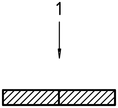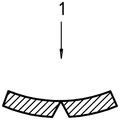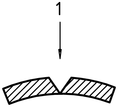ISO 6603-1-2000 “Plastics – Determination of puncture impact behaviour of rigid plastics – Part 1: Non-instrumental impact testing”
introduction
ISO (International Organization for Standardization) is a global alliance of national standards bodies (ISO member bodies). The development of international standards is usually carried out through ISO technical committees. Each member institution interested in a subject on which a technical committee has been established has the right to be represented on that committee. International governmental and non-governmental organizations liaising with ISO are also involved in this work. ISO works closely with the International Electrotechnical Commission (IEC) on all matters of electrical standardization.
International standards are drafted in accordance with the rules given in Part 3 of the ISO/IEC Directive.
The draft international standard adopted by the Technical Committee will be circulated to the member bodies for voting. Publication as an international standard requires approval by at least 75% of member institutions.
Please note that some elements of this part of ISO 6603 May be the subject of a patent right. ISO is not responsible for identifying any or all such patents.
The international standard ISO 6603-1 was developed by the Technical Committee ISO/TC61, Plastics, Subcommittee SC 2, Mechanical Properties.
ISO 6603-1-2000 “Plastics – Determination of puncture impact behaviour of rigid plastics – Part 1: Non-instrumental impact testing”
The second edition cancels and replaces the technically revised first edition (ISO 6603-1:1985).
ISO 6603 consists of the following parts, under the general heading Plastics – Determination of puncture impact behaviour of rigid plastics:
– Part 1: Non-instrumental impact testing
– Part 2: Instrumented impact testing
Appendix A of this part of ISO 6603 is for information purposes only.
1 Range
This standard specifies a method for determining, under specified conditions, the puncture impact properties of rigid plastics in the form of flat specimens, such as disks or squares. The sample can be molded directly, cut from the sheet or removed from the finished product. Different types of samples and test conditions are defined.
ISO 6603-1-2000 “Plastics – Determination of puncture impact behaviour of rigid plastics – Part 1: Non-instrumental impact testing”
These drop dart methods are used to study the behavior of plastic films or molds under the impact of a firing pin perpendicular to the specimen plane.
This part of ISO 6603 can be used if it is sufficient to characterize the impact behavior of plastics by an impact failure energy threshold based on many samples. If a force-deflection or force-time plot recorded at a nominal constant firing pin speed is necessary to characterize impact behavior in detail, ISO 6603-2 is used.
These test methods are suitable for specimens with thicknesses between 1 mm and 4 mm.
Note For thicknesses less than 1 mm, ISO 7765 is recommended. If the equipment is suitable, it is possible to test thicknesses greater than 4 mm, but this test falls outside the scope of ISO 6603-1 and ISO 6603-2.
These methods are suitable for the following types of materials:
Rigid thermoplastic molding and extrusion materials, including filled, unfilled and reinforced compounds and sheets;
– Rigid thermosetting molding and extrusion materials, including filling and reinforcing compounds, sheets and laminates;
ISO 6603-1-2000 “Plastics – Determination of puncture impact behaviour of rigid plastics – Part 1: Non-instrumental impact testing”
Fiber-reinforced thermoset and thermoplastic composites, including unidirectional or non-unidirectional reinforcement materials, such as MATS, woven fabrics, woven roving, cut strands, combined and mixed reinforcement materials, roving, milled fibers and sheets made from pre-impregnated materials (prepregs).
These methods are also applicable to samples molded or machined from finished products, laminates and extruded or cast plates.
The test results are comparable only when the preparation conditions, size and surface of the sample and the test conditions are the same. In particular, the results determined on specimens of different thicknesses cannot be compared with each other (see Appendix E: – to ISO 6603-2). A comprehensive assessment of the impact stress response requires measurement of the impact velocity and temperature of different material variables, such as crystallinity and moisture content.
The impact behavior of the finished product cannot be predicted directly from this test, but samples can be taken from the finished product (see above) for testing by these methods.
Test data developed through these methods should not be used in design calculations. However, information on the typical behaviour of the material can be obtained by testing at different temperatures and impact velocities (see Annex D of ISO 6603-2: -), varying thickness (see Annex E of ISO 6603-2: -) and testing samples prepared under different conditions.
This part of ISO 6603 describes two statistical test methods:
– Method A: Staircase Method (Individual) (preferred)
In this method, a uniform energy increment is used during the test. After testing each sample, the energy is reduced or increased by uniform increments, depending on the observations (pass or fail) of the previous test.
ISO 6603-1-2000 “Plastics – Determination of puncture impact behaviour of rigid plastics – Part 1: Non-instrumental impact testing”
– Method B: Group method (Optional)
In this method, a continuous group of at least ten samples is tested. The impact failure energy is calculated statistically.
2 Normative references
The following normative documents contain provisions that, by reference herein, constitute the provisions of this part of ISO 6603. For dated references, any subsequent revisions or amendments to these publications will not apply. However, Parties to agreements based on this part of ISO 6603 are encouraged to investigate the possibility of applying new versions of the following normative documents. For undated references, a new version of the standard-setting document referred to applies. ISO and IEC members maintain a register of currently valid international standards.
ISO 291:1997, Plastics. Adjust and test the standard atmosphere.
ISO 293:1986, Plastics. Compression forming sample of thermoplastic material.
ISO 294-3:1996, Plastics. Injection molding of thermoplastic material samples. Part 3: Small board.
ISO 295:1991, Plastics. Compression molding of thermosetting material samples.
ISO 1268:19741), Plastics – Preparation of glass fiber reinforced, resin bonded, low pressure laminates or panels for test purposes.
ISO 2818:1994, Plastics. The sample was prepared by machining.
ISO 7765-1:1988, plastic films and sheets. The impact resistance was determined by the free falling dart method. Part 1: Staircase method.
ISO 7765-2:1994, plastic films and sheets. The impact resistance was determined by the free fall dart method. Part 2: Instrumental puncture test.
ISO 6603-1-2000 “Plastics – Determination of puncture impact behaviour of rigid plastics – Part 1: Non-instrumental impact testing”
3 Terms and definitions
For the purposes of this part of ISO 6603, the following terms and definitions apply:
3.1 Overview
3.1.1 Failure
Any visible breakage of the specimen surface
3.2 Failure standard terms
3.2.1 Crack
Any cracks that are visible to the naked eye and cannot penetrate the entire thickness of the material
See: Figure 1
3.2.2 Broken
Any cracks throughout the entire thickness of the material
See: Figure 2
3.2.3 Penetration
Failure of the firing pin to penetrate the entire thickness of the specimen
See: Figure 3 b)
3.2.4 Grinding
Break the sample into two or more pieces
See: Figure 3 a)
3.3 Impact failure items
3.3.150 % impact failure energy E50
The energy that causes 50% of the sample to fail, as defined in 3.1.1
3.3.250 % impact failure mass M50
The mass that causes 50% of the sample to fail at a given fall height, as defined in 3.1.1
3.3.350 % impact failure mass H50
50% impact failure height H50 uses the height at which a given falling mass causes 50% sample failure, as defined in 3.1.1
Figure 1 – Specimen sections damaged by “cracks” [b) and c) after bending by hand
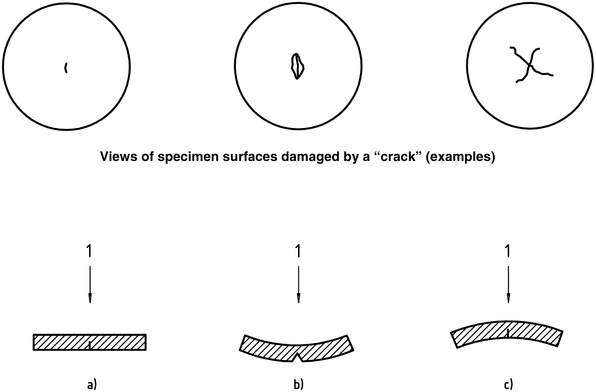
| 1 | Impact direction |
ISO 6603-1-2000 “Plastics – Determination of puncture impact behaviour of rigid plastics – Part 1: Non-instrumental impact testing”
Figure 2 – Slices passed through the specimen are damaged by “breakage” [b) and c) after bending by hand
| a)
| b)
| c)
|
| 1 | Impact Direction |
Figure 3 – Examples of “broken” failures [a) and “penetrated” [b)
a)
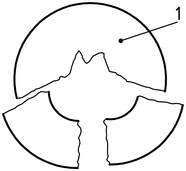
b)
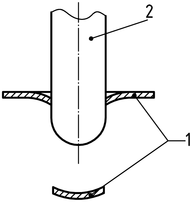
| 1 | Specimen |
| 2 | Darts with hemispherical heads |
Only the standard information section is public. To see the full content, you need to purchase the standard through the official channels.

